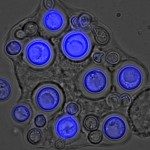Link to Pubmed [PMID] – 26768709
Link to DOI – 10.1016/j.fgb.2016.01.003S1087-1845(16)30002-0
Fungal Genet Biol 2016 Feb; 87(): 22-9
Cryptococcus neoformans var. neoformans (serotype D) represents about 30% of the clinical isolates in Europe and is present less frequently in the other continents. It is the prevalent etiological agent in primary cutaneous cryptococcosis as well as in cryptococcal skin lesions of disseminated cryptococcosis. Very little is known about the genotypic diversity of this Cryptococcus subtype. The aim of this study was to investigate the genotypic diversity among a set of clinical and environmental C. neoformans var. neoformans isolates and to evaluate the relationship between genotypes, geographical origin and clinical manifestations. A total of 83 globally collected C. neoformans var. neoformans isolates from Italy, Germany, France, Belgium, Denmark, Greece, Turkey, Thailand, Japan, Colombia, and the USA, recovered from different sources (primary and secondary cutaneous cryptococcosis, disseminated cryptococcosis, the environment, and animals), were included in the study. All isolates were confirmed to belong to genotype VNIV by molecular typing and they were further investigated by MLST analysis. Maximum likelihood phylogenetic as well as network analysis strongly suggested the existence of a recombinant rather than a clonal population structure. Geographical origin and source of isolation were not correlated with a specific MLST genotype. The comparison with a set of outgroup C. neoformans var. grubii isolates provided clear evidence that the two varieties have different population structures.

